10,000 Troops 2,000 Troops Date 10 October 1911 | ~4,000 Killed ~1,000 Killed | |
 | ||
Similar Xinhai Revolution, National Protection War, Northern Expedition, Taiping Heavenly Kingdom, First Sino‑Japanese War | ||
The Wuchang Uprising was the Chinese uprising that served as the catalyst to the Xinhai Revolution, ending the Qing Dynasty – and two millennia of imperial rule – and ushering in the Republic of China (ROC). It began with the dissatisfaction of the handling of a railway crisis. The crisis then escalated to an uprising where the revolutionaries went up against Qing government officials. The uprising was then assisted by the New Army in a coup against their own authorities in the city of Wuchang, Hubei province on October 10, 1911. The Battle of Yangxia led by Huang Xing would be the major engagement in the uprising.
Contents
- Canton and Sichuan railway crisis
- Revolutionary groups and a bombing incident
- New Army mutiny
- Sacrificial ceremony
- Establishment of Hubei military government
- Battle of Yangxia
- Aftermath
- Culture
- References
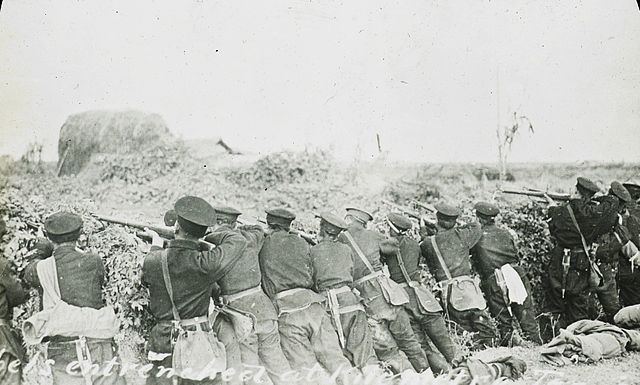
Canton and Sichuan railway crisis
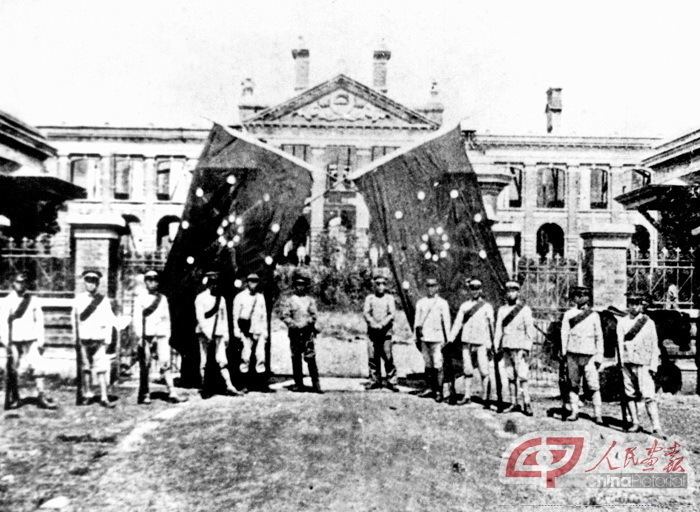
After the Boxer Rebellion, many Western countries saw China as a good location for railway building and investment. Having carved out their individual spheres of influence, countries such as the United Kingdom and France built numerous railways over the Qing government's protests. Germany began building lines in Shandong, the British in Yangtze Valley, French in Kunming, Russians in Heilongjiang and the Japanese had the Southern Manchuria Railway company.
The Qing government began to allow the provincial governments to set up their own railway construction ventures. By 1905, the Canton-Hankou Railway and the Sichuan-Hankou railway (川漢鐵路) were being locally managed in Guangdong, Hunan, Hubei and Sichuan. The railways were meant to link those provinces with the rest of China.
In May 1911 the Qing government ordered the nationalization of railway lines, previously paid for by local private investors, in order to pay for the indemnities imposed by the Boxer Protocol. The announcement to nationalize the railways in order to pay back debts to the antagonistic victors of the Boxer Rebellion—mainly Great Britain, Germany, France and the US—was met with much opposition. Protests were held in Changsha and people in Guangdong boycotted government banknotes. By July the Qing government compensated the investors, but the amount offered to Sichuan was much lower than all other provinces.
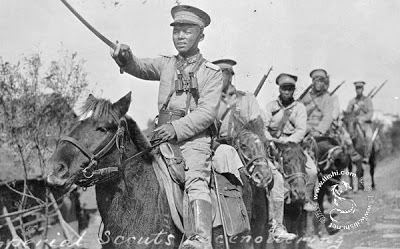
By August 11 there were massive strikes and rallies at Chengdu. On September 7, Governor-General Zhao Erfeng arrested key leaders of the Railway Protection League, and when a crowd formed to protest this, ordered troops to fire into the crowd. New Army units in Wuhan were stationed in Wuchang, Hankou and Hanyang at the time.
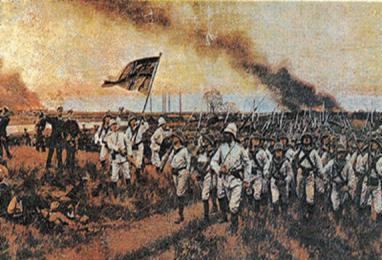
Meanwhile, the press and radical students in both Hunan and Hubei were already harshly criticizing local elites for their relative lack of outrage in response to the railway nationalization (as compared to their counterparts in Sichuan). In this atmosphere of heated rhetoric, the public mood began to shift away from the vague belief that the Qing dynasty was going to end and towards the concrete wish that it should end.
Revolutionary groups and a bombing incident
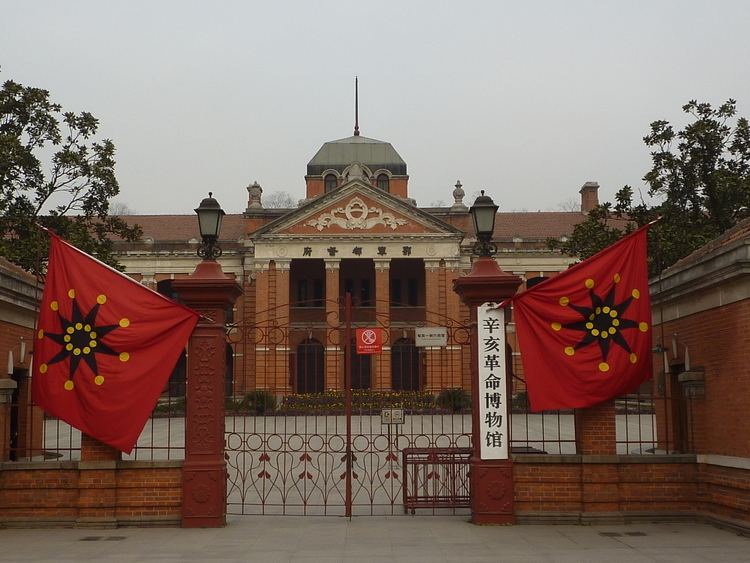
The uprising itself broke out by accident. At the time there were two local revolutionary groups in Wuhan, the Literary Society (文學社) and the Progressive Association (共進會). The two groups worked together, led by Jiang Yiwu (蔣翊武) and Sun Wu (孫武). In September 1911 they began collaborating with the Tongmenghui (同盟會). The original uprising date was set for October 6 on Mid-Autumn festival. However, some people were not ready on that date, and so it was postponed. On October 9 Sun Wu was at the Russian concession of Hankou where bombs were being built. A bomb accidentally exploded, causing Sun Wu serious injuries. When he was sent to the hospital, the staff discovered the group were revolutionaries and alerted the Qing government.
New Army mutiny
Facing arrest and certain execution with their identities now revealed, the revolutionaries had no choice but to stage a coup. Qing Viceroy of Huguang Duan Zheng (瑞澂) tried to track down the revolutionaries. Jiang Yiwu of the Literary Society decided to launch an attack that night, but the plot was discovered by Qing agents. Several members were arrested and executed.
Xiong Bingkun (熊秉坤) then decided to revolt on the evening of October 10 at 7pm. The modernized New Army in Wuchang staged a mutiny. While the New Army belonged to the Qing government, many of its soldiers were ready to switch their allegiance to the then-exiled anti-Qing revolutionary leader Sun Yat-sen. The revolutionaries took over the government office of Duan Zheng, who managed to avoid capture by escaping through a tunnel. After fierce fighting, the army captured strategic points in the city. More revolutionaries joined the insurrectionists and the government troops were defeated.
Sacrificial ceremony
Just one week after the start of the Wuchang uprising, Li Yuanhong (黎元洪) made a sacrifice to Heaven, Earth and the Yellow Emperor. A wide earthen platform was constructed on a military parade ground near the government offices. Five sacrificial offerings were made on an altar for incense, wine and an ox, according to tradition. Li and the officers kowtowed four times, while a prayer was read that told of the persecution of the Han by the Manchus and called the Yellow Emperor to assist in the establishment of the Republic. At the end, the soldiers raised their guns and shouted "Ten thousand years!" three times.
Establishment of Hubei military government
On October 11 the New Army established a military government in Hubei and Li Yuanhong was forced to become the new governor. It took some persuading to get him to "accept" the post, as one report said that he was hiding under a bed to avoid the position.
Once the army had taken the city it went to the Yellow Crane Tower to raise the "Iron Blood 18-star flag". This new military government called for other provinces to support the revolution and declared the founding of the Republic of China. This temporary government was referred to as the "Military Government of Hubei of the Republic of China" (湖北軍政府). By October 12 Hankou and Hanyang also fell into the hands of the revolutionaries.
Battle of Yangxia
The Qing government responded in October by ordering commander-in-chief Yuan Shikai (袁世凱) and the Beiyang Army to suppress the uprising in Wuchang. Huang Xing (黃興) would arrive in Wuhan in early November to take command of the revolutionary army. The revolutionaries and the loyalists fought a protracted battle in Hankou and Hanyang known as the Battle of Yangxia that would last until December 1. Although the loyalists eventually captured both towns, Yuan Shikai halted the advance of the Beiyang Army and agreed to a ceasefire. Negotiations began on December 1.
Aftermath
Sun Yat-sen himself played no direct part in the uprising in Wuchang. He was traveling in the United States, trying to drum up financial support from overseas Chinese. At the time he was in Denver at the foot of the Rocky Mountains. He received a telegram from Huang Xing that was one week old, but he could not decipher it because he did not have the secret key with him. The next morning he read in the newspaper that the city of Wuchang was occupied by the revolutionaries. After the Wuchang Uprising, the revolutionaries telegraphed the other provinces asking them to declare their independence, and 15 provinces in Southern China and Central China did so.
Representatives from the seceding provinces met and declared the founding of the Republic of China on January 1, 1912. Sun Yat-sen would return to China in December 1911 to be elected provisional president of the Republic of China. He eventually agreed to cede his provisional presidency to Yuan Shikai, in exchange for Yuan's help in pressuring the Last Emperor to abdicate. On February 12, 1912, Puyi, the Last Emperor, stepped down from the throne. The Qing dynasty could no longer govern itself, as it seemed to have forfeited the mandate of heaven. This brought an end to the imperial era.
Culture
The date of the uprising, October 10, widely known as Double Ten Day (Chinese: 雙十節), is celebrated as the National Day (Chinese: 國慶日) of the Republic of China. It is one of the most important national holidays in Taiwan.
October 10 is not the National Day of the People's Republic of China, but there may also be memorial activities in mainland China, usually referring to the day as the Anniversary for the Wuchang Uprising (Chinese: 武昌起义纪念日). The equivalent celebration is usually done on October 1 on the National Day of the People's Republic of China.
